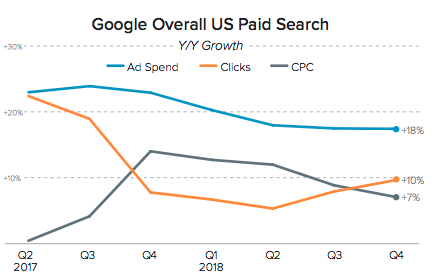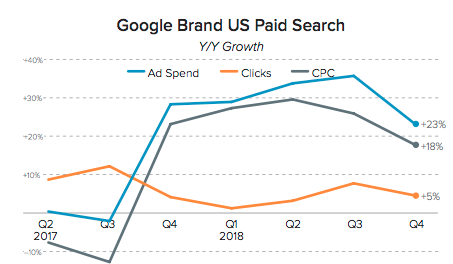As the paid search industry migrated towards a more automated environment advertisers were met with a spike in cost per click (CPC). Coming out of 2018 Merkle reports a higher rate of click growth than rise in CPC. Advertisers worked over the past year to harness automation and understand how to reap the benefits without inflating costs. Below are a few proven tips to help investigate why paid campaigns continue to encounter CPC inflation into Q1 of 2019.
|
|
|
Tips to Lower High Cost Per Click
Many advertisers continue to report a rise in despite the downward trend reported industry-wide. My team recently acquired an account where the CPC had doubled in the past year with the largest increase coming out of Q4 when the Merkle reported a shift back towards the norm.

The process below are areas we investigated in order to help understand why and formulate next steps to lower with the end goal being a CPA that was in line with the clients 3-year rolling average.
Check the Competition
A great starting point is to dive into Auction Insights to glean any yearly, quarterly or monthly shifts. In many markets we are seeing an increase in competition from big brand names, such as Amazon.

A shift in competition can be the result of many different account factors and the next step is to consider why: Is it a result of keyword expansion, a new competitor in the auction, a more aggressive existing competitor, etc. Reviewing the cost vs the return can help marketers decide if the expansion is worthwhile or if going head to head with a large heavy hitter is worth the rise in CPC.
End Goal Focused Automation
Investigate the type of automation used by the campaign and consider if it is the best method to get the desired results. When reviewing this aspect of the account, focus more on the CPA or ROAS. The goal of this analysis is to reach a happy medium. If we are able to get more conversions at a higher cost per click then the rise will be justified.
In the account example, our high funnel broad campaigns were set to maximize conversions. A separate broad campaign utilizing TCPA had a discrepancy in reporting between Salesforce and Google Ads, which led to a higher CPQL (cost per qualified lead). In Campaigns reporting a lower CPA we recommended leaving on maximum conversions.

Campaign Structure
When considering automated bid strategies one area highly recommended to review is the account structure. The use of automation requires data collected faster, smarter, more accurately, and from a wider sample base. Without volume the algorithm can jump to the wrong conclusions. The data sample must also have synergies. Many marketers are segmenting campaigns by intent. This allows the algorithm and the marketer to consider different goals and behaviors.
Quality Score
Another area to review when working to lower CPCs is ways to increase quality score. In this quest the focus is not on the actual quality score figure, identifying gaps for potential improvement. A few key areas I’ve found gaps include:
- Building out responsive text ads
- Comprehensive ad extensions
- Eliminating low performing
- Ensuring alignment of ad groups to landing page
This list doesn’t exhaust all the ways to lower CPCs. It is a starting point to help find the rabbit hole that will lead to an ah-ha moment in each unique account. This method simply has allowed us to begin to embrace automation without continuing to fall prey to the imperfections.






